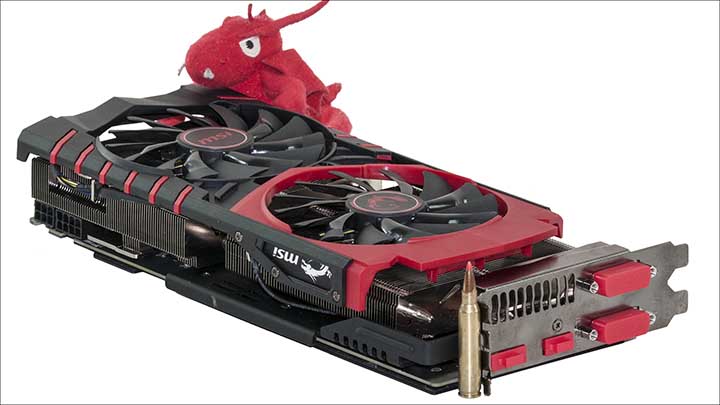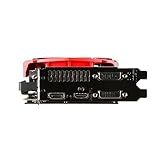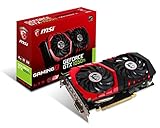 Red or Green, MSI does not care who powers their cards and instead use a very similar style shipping container for both types of video cards. Of course, that red styling does make more sense with AMD cards, but the reason AMD opted for Red for their Gaming series was to help differentiate it from their other popular series, and not because the lead designer is secretly an AMD fan. It does however make confusing say a MSI Gaming 6 GeForce GTX 980Ti for the R9 390X G8 a touch easier than we are comfortable with. In either case, this shipping container is about the same size as the typical ATX form-factored motherboard and this extra size allows MSI the luxury of plastering the back with details that will help you make an informed decision…and make confusing one card for another in their lineup your fault and only your fault.
Red or Green, MSI does not care who powers their cards and instead use a very similar style shipping container for both types of video cards. Of course, that red styling does make more sense with AMD cards, but the reason AMD opted for Red for their Gaming series was to help differentiate it from their other popular series, and not because the lead designer is secretly an AMD fan. It does however make confusing say a MSI Gaming 6 GeForce GTX 980Ti for the R9 390X G8 a touch easier than we are comfortable with. In either case, this shipping container is about the same size as the typical ATX form-factored motherboard and this extra size allows MSI the luxury of plastering the back with details that will help you make an informed decision…and make confusing one card for another in their lineup your fault and only your fault. MSI never goes overboard on the included accessories, but given the fact that we would take a lower asking price over goo-gaws and trinkets, we really cannot fault MSI too much for this approach. After all, this model is only $5 more than our usual reference R9 390X and MSI does cover off the bases nicely. In grand total you will get a single 6pin PCI-e to 8pin PCIe adapter, a quick start guide, a CD with the necessary drivers, a pamphlet going over some of MSI’s other offerings, and dust covers for all the rear I/O ports. The only thing that is really missing is a DVI to D-Sub adapter – and consumers who still use analog monitors but are willing to spend 4-plus bills on a video card can be counted on one hand.
MSI never goes overboard on the included accessories, but given the fact that we would take a lower asking price over goo-gaws and trinkets, we really cannot fault MSI too much for this approach. After all, this model is only $5 more than our usual reference R9 390X and MSI does cover off the bases nicely. In grand total you will get a single 6pin PCI-e to 8pin PCIe adapter, a quick start guide, a CD with the necessary drivers, a pamphlet going over some of MSI’s other offerings, and dust covers for all the rear I/O ports. The only thing that is really missing is a DVI to D-Sub adapter – and consumers who still use analog monitors but are willing to spend 4-plus bills on a video card can be counted on one hand. Moving on to the real star of the show, when we first took it out of the shipping container we were taken aback by what MSI has created. Tipping the scales at 1.312 kilograms this card is bloody massive… and yet not so large as to have negatives outweigh its positives. This really is becoming a trend with MSI’s Gaming series and we must admit to be being impressed by this rather bold design philosophy.
Moving on to the real star of the show, when we first took it out of the shipping container we were taken aback by what MSI has created. Tipping the scales at 1.312 kilograms this card is bloody massive… and yet not so large as to have negatives outweigh its positives. This really is becoming a trend with MSI’s Gaming series and we must admit to be being impressed by this rather bold design philosophy.
Think Big really could be the unofficial motto of this card, and if you were to place this card next to a reference R9 390X no one would ever guess that it only cost a couple dollars more. The red, black, and naked silver design aesthetics are a touch aggressive for our liking but they do make this card stand out and making it the centerpiece of a custom build really would be rather easy. The only issue with making their R9 390X Gaming 8 so pretty and aggressive is that it looks even bigger than it is – and this is no petite card. As with previous Gaming series MSI video cards this card is wider than your typical video card, specifically they have made it about 29mm wider than reference sized cards. This will make installing it into smaller cases difficult, but as long as your side panel is not right next to the GPU, and instead is pushed out a bit to make room for side panel fans, you will be fine.
The only issue with making their R9 390X Gaming 8 so pretty and aggressive is that it looks even bigger than it is – and this is no petite card. As with previous Gaming series MSI video cards this card is wider than your typical video card, specifically they have made it about 29mm wider than reference sized cards. This will make installing it into smaller cases difficult, but as long as your side panel is not right next to the GPU, and instead is pushed out a bit to make room for side panel fans, you will be fine. By itself this issue is really a non-issue for most PC gaming enthusiasts, but what may cause some to pause for thought is that this card is also taller than a typical video card. Most video cards use a 2 PCIe slot design in that they are about 40mm tall. This card makes use of the unusual form-factor that is common referred to as a “2.5 slot” form-factor and is 51mm high – or 27.5% taller.
By itself this issue is really a non-issue for most PC gaming enthusiasts, but what may cause some to pause for thought is that this card is also taller than a typical video card. Most video cards use a 2 PCIe slot design in that they are about 40mm tall. This card makes use of the unusual form-factor that is common referred to as a “2.5 slot” form-factor and is 51mm high – or 27.5% taller.
For some consumers this will make using this card in CrossFire configurations impossible, as their motherboard’s two main PCIe x16 slots are only spaced 2 slots apart. However, that is becoming less common with PC gaming orientated motherboards and most now use two PCIe slots as a buffer between the two main PCIe x16 slots. This was done to increase airflow to the topmost video card, but it does negate airflow as a reason to not purchase two of these cards. Specifically even though the gap between two of these R9 390X Gaming 8 cards would only be about 9mm that is still enough air gap to allow both cards to run cool. It is however an issue you need to be aware of before opting for this plus-sized card. On the positive side MSI has not wasted this room and instead has used it to make a(nother) custom version of their TWIN FROZR V heatsink. This time the TF V fin array is basically 2 PCIe slots high -instead of 1.5 like in most – and is the full width and length of the cards 277mm X 129mm footprint. Mix in multiple heatpipes, a secondary heatsink for the RAM, and two large fans and the end result is the most robust Twin Frozr V heatsink we have ever seen.
Specifically even though the gap between two of these R9 390X Gaming 8 cards would only be about 9mm that is still enough air gap to allow both cards to run cool. It is however an issue you need to be aware of before opting for this plus-sized card. On the positive side MSI has not wasted this room and instead has used it to make a(nother) custom version of their TWIN FROZR V heatsink. This time the TF V fin array is basically 2 PCIe slots high -instead of 1.5 like in most – and is the full width and length of the cards 277mm X 129mm footprint. Mix in multiple heatpipes, a secondary heatsink for the RAM, and two large fans and the end result is the most robust Twin Frozr V heatsink we have ever seen. The reason for this upgraded heatsink is because even though the Grenada XT core is cooler running than its predecessor it still is a 275TDP design. This makes even reference speed R9 390X’s rather hot running. On its own we are sure that a typical Twin Frozr V heatsink would be more than enough, but MSI has overclocked their R9 390X Gaming 8 – which means even more heat is produced. A standard R9 390X has its core running at 1,150Mhz and the RAM clocked to an effective 61Mhz. MSI has applied a factory overclock to both and this R9 390X has its Grenada XT running at a maximum frequency of 1,100Mhz, and the RAM running at 6,100MHz.
The reason for this upgraded heatsink is because even though the Grenada XT core is cooler running than its predecessor it still is a 275TDP design. This makes even reference speed R9 390X’s rather hot running. On its own we are sure that a typical Twin Frozr V heatsink would be more than enough, but MSI has overclocked their R9 390X Gaming 8 – which means even more heat is produced. A standard R9 390X has its core running at 1,150Mhz and the RAM clocked to an effective 61Mhz. MSI has applied a factory overclock to both and this R9 390X has its Grenada XT running at a maximum frequency of 1,100Mhz, and the RAM running at 6,100MHz. To put that another way the core is overclocked by 4.5% and the ram is overclocked at the factory by over nearly 2%. That may not sound like much, but this overclock in conjunction with the Gaming series special ability to run passively when the core is idling does account for the need for a massive heatsink. Quite honestly zero decibel R9 390X is bloody impressive and easily justifies the minor installation issues that may crop up with using oversized dimensions.
To put that another way the core is overclocked by 4.5% and the ram is overclocked at the factory by over nearly 2%. That may not sound like much, but this overclock in conjunction with the Gaming series special ability to run passively when the core is idling does account for the need for a massive heatsink. Quite honestly zero decibel R9 390X is bloody impressive and easily justifies the minor installation issues that may crop up with using oversized dimensions. Interestingly enough MSI feels that one 6-pin and one 8-pin PCIe power connector is all that is needed to properly power this card. This is a touch controversial but given the fact that R9 390X’s are not known for their great overclocking headroom 300 watts of power (75 from the slot, 75 from the 6-pin, and 150 from the 8-pin) should prove to be more than enough to not be a problem for overclocking enthusiasts.
Interestingly enough MSI feels that one 6-pin and one 8-pin PCIe power connector is all that is needed to properly power this card. This is a touch controversial but given the fact that R9 390X’s are not known for their great overclocking headroom 300 watts of power (75 from the slot, 75 from the 6-pin, and 150 from the 8-pin) should prove to be more than enough to not be a problem for overclocking enthusiasts. By gently removing the heatsink we can see that MSI uses ‘only’ a 6+1 all digital power delivery subsystem phase for this card.
By gently removing the heatsink we can see that MSI uses ‘only’ a 6+1 all digital power delivery subsystem phase for this card. This is certainly a downgrade from say the GeForce GTX 980Ti Gaming 6, but once again the components used are all ‘military grade’ components and should prove to be more than capable of delivery stable power at even further overclocked levels. To help keep the VRM components cool they are connected directly to the massive fin array via heatpads. This should easily keep these components cool even during extended gaming marathon sessions.
This is certainly a downgrade from say the GeForce GTX 980Ti Gaming 6, but once again the components used are all ‘military grade’ components and should prove to be more than capable of delivery stable power at even further overclocked levels. To help keep the VRM components cool they are connected directly to the massive fin array via heatpads. This should easily keep these components cool even during extended gaming marathon sessions. Equally impressive is that the memory ICs themselves also get their own heatsink. This small low profile black heatsink may lack cooling fins, but since it covers a good portion of the board, more than enough exhaust air from the main heatsink will flow over it and keep the ICs cool – even when you push their speeds higher. This is one of the nice little touches MSI are known for that make overclocking their cards easier.
Equally impressive is that the memory ICs themselves also get their own heatsink. This small low profile black heatsink may lack cooling fins, but since it covers a good portion of the board, more than enough exhaust air from the main heatsink will flow over it and keep the ICs cool – even when you push their speeds higher. This is one of the nice little touches MSI are known for that make overclocking their cards easier. As expected this heavy cooler uses a full length black backplate that adds rigidity and should keep it from ‘sagging’ even after years of use. As an added bonus it does give the card a nice and finished look that is lacking on video cards that don’t include a backplate.
As expected this heavy cooler uses a full length black backplate that adds rigidity and should keep it from ‘sagging’ even after years of use. As an added bonus it does give the card a nice and finished look that is lacking on video cards that don’t include a backplate. The input selection of the MSI R9 390X Gaming 8 is actually the only part of this card that bares even a passing resemblance to reference R9 390X cards. As with a reference card, the rear bracket is only 2 slots high and the top row is split nearly evenly between exhaust slits and a single DVI port, while the bottom row has a second DVI-D port, a single HDMI port, and a single Display Port. This is a decent selection of options, but we do wish they had used the extra slot for more ports. For example an extra Display Port would have been nice.
The input selection of the MSI R9 390X Gaming 8 is actually the only part of this card that bares even a passing resemblance to reference R9 390X cards. As with a reference card, the rear bracket is only 2 slots high and the top row is split nearly evenly between exhaust slits and a single DVI port, while the bottom row has a second DVI-D port, a single HDMI port, and a single Display Port. This is a decent selection of options, but we do wish they had used the extra slot for more ports. For example an extra Display Port would have been nice.











